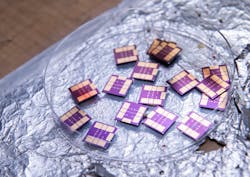Colloidal quantum dots generate infrared light
A team of University of Chicago researchers led by Philippe Guyot-Sionnest, a professor of physics and chemistry, recently figured out a way to create infrared light via colloidal quantum dots—and opened the door to redefining what’s possible in the mid-infrared range (3–5 µm) because the dots they achieved on their first try are nearly as efficient as existing conventional methods (see video).
Colloidal quantum dots are 5- to 20-nm semiconductor nanocrystals/particles—commonly made out of cadmium selenide (CdSe), cadmium sulfide (CdS), lead sulfide (PbS), zinc oxide (ZnO), and indium phosphide (InP), etc.—that possess unique optical and electronic properties. The electron wave resonates inside these particles and, just like sound or optical waves within a cavity, it creates stationary states spectrally tunable by the nanocrystal’s size.
Quantum dots that generate light in the visible range are already found in commercial products like light-emitting diodes (LEDs) and televisions. But until now, if you wanted quantum dot light in the mid-infrared range, you’ve been largely out of luck.
While organic molecules are made with light atoms and ideal for dyes and fluoresce in the visible range, they’re not so great in the mid-infrared range simply because molecular vibrations are also in the mid-infrared and rapidly quench the electronic excitations.
“Inorganic semiconductor quantum dot materials are soluble like dye molecules and have tunable electronic excitations in the mid-infrared, but they’re made of heavy atoms with much lower frequency vibrations and it makes them good infrared and solution-processable materials,” says Guyot-Sionnest. “This is the idea behind our work on infrared semiconductor quantum dots—and it began 25 years ago.”
Infrared lasers are currently made via a molecular epitaxy process and, although it works well, it’s labor-intensive and expensive. So the researchers wondered if they could come up with a better method based on quantum dots.
Quantum mechanics and a cascade effect
The team decided to explore a “cascade” technique widely used to make lasers, which hadn’t been achieved via colloidal quantum dots. To do it, they made a black ink of trillions of tiny nanocrystals made of core/shell HgSe/CdSe, spread it onto a conducting electrode, evaporated a second conducting electrode on top, and ran an electrical current through it.
Their approach involves running an electrical current across a device to send millions of electrons across it. If successful, electrons travel through a series of distinct energy levels, akin to falling down a series of waterfalls. Each time the electron drops down an energy level, it has the chance to emit energy as light. It works thanks to quantum mechanics.
“In our cascade LED, we work with two states of the quantum dots: the lowest ground state, which is like the s state of a hydrogen atom, and the first excited state, which is like the p state,” explains Guyot-Sionnest. “Mid-infrared light is emitted when the electron relaxes from p to s. And the bias between the dots allows the electrons to tunnel from this s state into the p state of the next dot, and so on.”
To the team’s astonishment, on their first attempt to generate infrared light via colloidal quantum dots they saw light. “Our novel approach to infrared light generation was quite efficient for a first try, and its performance will improve by a couple orders of magnitude once the efficiency at which the light is produced inside the dots is improved,” says Guyot-Sionnest. “Then, these light sources will combine unprecedented efficiency and low cost.”
The preferred tunneling “from the s state of one dot to the p state of the next dot is far from obvious, because there is also the possibility of simply tunneling from s to s of the next dot,” Guyot-Sionnest explains. “We initially thought this preference would require a resonance at a finely tuned bias, but in some yet unclear way the electrons arrange themselves to cascade rather than flow down so that the bias is not critical.”
There were no major challenges involved in this work, since it was an application of the team’s prior work within the lab to make fluorescent infrared quantum dots, and they already had experience making the first mid-infrared LEDs with quantum dots and measuring their output light.
“But it did require an unusual combination of skills at the interface of chemistry and physics,” Guyot-Sionnest says. “And this is to the credit of Xinygyu Shen and Ananth Kamath. There are few groups that combine the chemical skill in making the quantum dots, the fabrication tools to make the devices, and the mid-infrared instrumentation to characterize the properties.”
Optical gas sensors and lasers ahead
The most obvious and likely application for infrared light generated via quantum dots is optical gas sensors. “Large printed production of fast and efficient quantum dot LEDs, along with similarly fast and efficient quantum dot detectors, will allow optical gas sensing to be done much more cheaply than with the present semiconductor technology,” says Guyot-Sionnest. “It will also provide much better sensitivity than the less expensive technology based on thermal sources and pyroelectric detectors.”
Lasers are one possible extension of this work, but this is still uncertain whether it can be achieved. Beyond this, commercial applications will likely require using quantum dots without the toxic and regulated elements of mercury, cadmium, and lead.
“A cost-effective and easy-to-use method to make infrared light with quantum dots could be very useful,” says Xingyu Shen, a graduate student working with Guyot-Sionnest.
About the Author
Sally Cole Johnson
Editor in Chief
Sally Cole Johnson, Laser Focus World’s editor in chief, is a science and technology journalist who specializes in physics and semiconductors.


